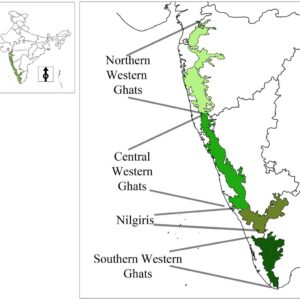Published on: December 12, 2022
WESTERN GHATS
WESTERN GHATS
Why in news? Karnataka has decided to oppose the Eco Sensitive Area (ESA) notification in its entirety by citing the lack of compensation from the Centre, a recommendation of the Kasturirangan Committee report.
Highlights:
- Union government has appointed a five-member committee to revise the Eco Sensitive Area (ESA) notification for the Western Ghats in six states
- National Green Tribunal, the Ministry of Environment, Forests and Climate Change (MoEF&CC) issued the draft notification for the third time, declaring as ESA 56,825 sqkm spread across Karnataka, Maharashtra, Kerala, Tamil Nadu and Goa
- The MoEF has bought time from the NGT by setting up a five-member committee, headed by former Director General of Forests, MOEF, Sanjay Kumar, to look into the suggestions and objections by the states.
Why Karnataka is opposing ?
- In the ESA notification, the Centre is silence on a key aspect of the Kasturirangan report on compensating states for removing large areas from economic activities.
- The Kasturirangan report had underscored the recommendation of the 13th Finance Commission, which had batted for a compensation of Rs 5,000 crore to the states for maintaining forests.
- The report sought computation of hydrological service provided by the Ghats with paying for the well-being of the local communities.
- By agreeing to ESA, Karnataka will remove about 11% of its total geographical area from major economic activities.
- Karnataka is set to raise the issue of compensation before the committee, which is expected to deliver its report 2023.
- Karnataka has one third of the ESA, it was felt that the Centre cannot overlook the compensation part when it cites the Kasturirangan report to protect the forests.
What are the recommendations of the Kasturirangan committee report?
- The report proposes 37 per cent of the total area of Western Ghats, which is roughly 60,000 square kilometres, to be declared as eco-sensitive area (ESA).
- Out of this, 20,668 sq km of the area falls in Karnataka covering 1,576 villages.
- The report recommended a blanket ban on mining, quarrying, setting up of red category industries and thermal power projects.
- It also stated that the impact of infrastructural projects on the forest and wildlife should be studied before permission is given for these activities.
- Report stated that the UNESCO Heritage tag is an opportunity to build global and domestic recognition of the enormous natural wealth that exists in the Western Ghats.
- The 39 sites are located across the Western Ghats and distributed across the states (Kerala 19), Karnataka (10), Tamil Nadu (6) and Maharashtra (4).
- The boundary of the sites, are in most cases, boundaries of the legally demarcated national parks, wildlife sanctuaries, tiger reserves and forest divisions and therefore, already accorded with high level of protection.
- The Eco-Sensitive Area mapping and demarcation done by the committee also indicates that all sites are within this area.
- The state of Karnataka has the highest percentage of the Eco Sensitive Area- 46.50 per cent.
About Western Ghats
- States : Gujarat, Maharashtra, Goa, Karnataka, Kerala and Tamil Nadu.
- UNESCO World Heritage Site and is one of the eight biodiversity hotspots in the world
- The range is known as Sahyadri in Maharashtra and Karnataka.
- It is sometimes called the Great Escarpment of India, older than Himalayan
- Separates the plateau from a narrow coastal plain called Konkan along the Arabian Sea.
- The range starts near south of the Tapti river and ends at Marunthuvazh Malai near the southern tip of India.
- Major mountain passes : Charmudi ghat, Agumbe ghat, Kollur ghat, Hulikal ghat
- Nilgiris connect the Biligiriranga Hills in southeastern Karnataka with the Shevaroys and Tirumala hills.
- Ooty is called the Queen of the Western ghats.
- As per recent data Udupi district hosts wettest places Karnataka (Bairampalli)
- Dominant forests : Tropical rainforest, Montane forests, tropical dry forests and troical moist forests
- Major trees : Rosewood, Mahogany, Cedar etc.
- Threatened species : Tiger, leopard, lion-tailed macaque, Nilgiri tahr, Asian elephant, Nilgiri langur and gaur

